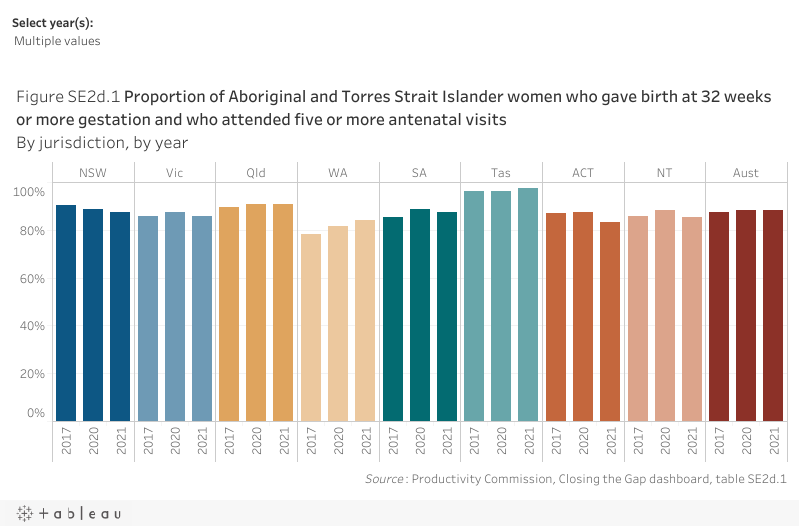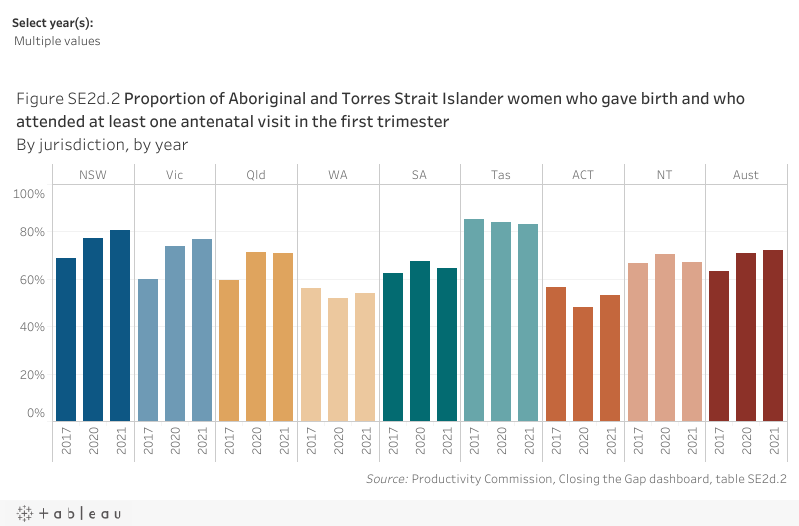Driver
Use of antenatal care by pregnant women
- proportion with five or more antenatal visits
- proportion with at least one antenatal care visit in the first trimester
Data tables appear under figures
Measure 1
Proportion of women with five or more antenatal visits
Nationally in 2021, 88.1% of Aboriginal and Torres Strait Islander women who gave birth at 32 weeks or more gestation attended five or more antenatal visits during pregnancy, an increase from 87.5% in 2017 (the baseline year) (figure SE2d.1).

Measure 2
Proportion of women with at least one antenatal care visit in the first trimester
Nationally in 2021, 72.0% of Aboriginal and Torres Strait Islander women who gave birth had attended at least one antenatal visit in the first trimester, an increase from 63.5% in 2017 (the baseline year) (figure SE2d.2).

Indicator data specifications
Related Outcome: | Aboriginal and Torres Strait Islander children are born healthy and strong. |
|---|---|
Related target: | By 2031, increase the proportion of Aboriginal and Torres Strait Islander babies with a healthy birthweight to 91% |
Indicator: | Use of antenatal care by pregnant women:
|
Measures: | There are two measures for this indicator. Measure 1 is the proportion of women with five or more antenatal visits defined as: Numerator – number of Aboriginal and Torres Strait Islander women who gave birth at 32 weeks or more gestation and who attended five or more antenatal visits Denominator – number of Aboriginal and Torres Strait Islander women who gave birth at 32 weeks or more gestation and is presented as a percentage. Measure 2 is the proportion of women with at least one antenatal care visit in the first trimester defined as: Numerator – number of Aboriginal and Torres Strait Islander women who gave birth and who attended at least one antenatal visit in the first trimester Denominator – number of Aboriginal and Torres Strait Islander women who gave birth and is presented as a percentage. |
Indicator established: | National Agreement on Closing the Gap July 2020 |
Latest dashboard update for the indicator: | 6 March 2024 |
Indicator type: | Driver |
Interpretation of change: | For both measures, a high or increasing proportion is desirable. |
Data source(s): | Name: National Perinatal Data Collection (NPDC) Frequency: Annual Documentation (links): https://www.aihw.gov.au/about-our-data/our-data-collections/national-perinatal-data-collection |
Data provider: | Provider name: Australian Institute of Health and Welfare (AIHW) Provider area: Perinatal |
Baseline year: | 2017 |
Latest reporting period: | 2021 |
Disaggregations: | Both measures: State and territory and Australia, by Indigenous status of mother. |
Computation: | Numerator divided by Denominator multiplied by 100. Counting rules Both measures The data relates to women who gave birth, whether resulting in a live or still birth. Births both less than 20 weeks gestation and less than 400 grams birthweight are not included in the NPDC. Indigenous status is that of the mother. The data is by state and territory of the usual residence of the mother. The data excludes Australian non‑residents, residents of external territories and records where state/territory of residence was not stated. Antenatal visits relate to care provided by skilled birth attendants for reasons related to pregnancy. Measure 1 Includes (numerator and denominator):
Excludes (numerator and denominator):
Measure 2 First trimester is up to and including 13 completed weeks. Excludes (numerator and denominator):
Supporting calculations
|
Data quality considerations: | Data for these measures align with similar measures in the Aboriginal and Torres Strait Islander Health Performance Framework. Both measures In the NPDC, Indigenous status is a measure of whether a person identifies as being of Aboriginal and/or Torres Strait Islander origin. All jurisdictions have a data item to record Indigenous status of the mother and Indigenous status of the baby on their perinatal form, although there are some differences among the jurisdictions. See https://www.aihw.gov.au/reports/mothers-babies/australias-mothers-babies/contents/technical-notes/data-quality-and-availability Data recorded about antenatal visits is based on visits recorded in the woman’s clinical record and may not include all antenatal visits outside the hospital setting, such as with a general practitioner or private obstetrician. The AIHW does not provide data for proportions based on denominators of less than 100 for reliability reasons. Proportions based on numerators of less than five are also not provided, with the exception of not stated categories. However, relevant data are included in the calculation for Australian totals. For the Australian Capital Territory, in many cases early antenatal care provided by the woman’s general practitioner is not reported. Measure 2 For the Australian Capital Territory, first antenatal visit is often the first hospital antenatal clinic visit. |
Future reporting: | Additional disaggregations required for future reporting:
|
